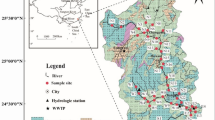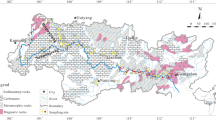Abstract
The concentrations of rare earth elements in the dissolved, acid-soluble and residual phases in surface waters of the Changjiang Estuary were determined using ICP-MS. The main purposes of the study are to understand the estuarine geochemistry of rare earth elements and to explore water-particle interactions in the Changjiang estuarine mixing zone. The results show that there are two distinct processes operating on dissolved rare earth elements in the estuary: large scale removal at low salinities due to salt-induced coagulation and remarkable release at mid to high salinities. These processes result in modification of the effective river water flux and the systematical fractionation of the dissolved rare earth elements toward the East China Sea. The increase in concentration of dissolved rare earth elements in the mid to high salinity waters of the Changjiang Estuary suggests a sediment source in the mixing zone of the estuary, which is located over a shallow, broad shelf where there is extensive physical contact between bottom sediment and estuarine waters. Acid-soluble rare earth elements, the concentrations of which also dropped sharply in the low salinity region, appear to be controlled by salt-induced coagulation process and intense deposition of suspended particulate matter in the low salinity region. In the mid to high salinities, all acid-soluble rare earth element concentrations increase slightly with increasing salinity, suggesting that resuspension of sediments occurred. In contrast, the residual rare earth element concentrations are relatively constant with salinity variation in the Changjiang estuarine surface waters.
Similar content being viewed by others
References
Beardsley, R. C., R. Limeburner, H. Yu and G. A. Cannon (1985): Discharge of the Changjiang (Yangtze River) into the East China Sea. Cont. Shelf Res., 4, 57–76.
Byrne, R. H. and J. H. Lee (1993): Comparative yttrium and rare-earth element chemistries in seawater. Mar. Chem., 44, 121–130.
Cai, D., F. C. Tan and J. M. Edmond (1992): Organic carbon isotope geochemistry of the Changjiang (Yangtze River) Estuary. Geochimica., 3, 305–311 (in Chinese with English abstract).
De Carlo, E. H., X.-Y. Wen and M. Irving (1998): The influence of redox reactions on the uptake of dissolved Ce by suspended Fe and Mn oxide particles. Aquatic Geochemistry, 3, 357–389.
Edmond, J. M., A. Spivack, B. C. Grant, M.-H. Hu, Z. Chen, S. Chen and X. Zeng (1985): Chemical dynamics of the Changjiang estuary. Cont. Shelf Res., 4, 17–36.
Elderfield, H., R. Upstill-Goddard and E. R. Sholkovitz (1990): The rare earth elements in rivers, estuaries, and coastal seas and their significance to the composition of ocean waters. Geochim. Cosmochim. Acta, 54, 971–991.
Goldstein, S. J. and S. B. Jacobsen (1988): Rare earth elements in river waters. Earth Planet. Sci. Lett., 89, 35–47.
Hung, J.-J., C.-L. Chan and G.-C. Gong (2007): Summer distribution and geochemical composition of suspended-particulate matter in the East China Sea. J. Oceanogr., 63, 189–202.
Koeppenkastrop, D. and E. H. De Carlo (1992): Sorption of rare-earth elements from seawater onto synthetic mineral particles: An experimental approach. Chem. Geol., 95, 251–263.
Koeppenkastrop, D. and E. H. De Carlo (1993): Uptake of rare earth elements from solution by metal oxides. Environ. Sci. Technol., 27, 1796–1802.
Lawrence, M. G. and B. S. Kamber (2006): The behaviour of the rare earth elements during estuarine mixing-revisited. Mar. Chem., 100, 147–161.
Li, J.-F., Q. He and C. Zhang (2000): A study on sediment deposition and resuspension in the mouth bar area of the Changjiang River Estuary. Oceanol. Limnol. Sin., 31, 101–109 (in Chinese with English abstract).
Négrel, P., C. Grosbois and W. Kloppmann (2000): The labile fraction of suspended matter in the Loire River (France): multi-element chemistry and isotopic (Rb-Sr and C-O) systematics. Chem. Geol., 166, 271–285.
Nozaki, Y., J. Zhang and H. Amakawa (1997): The fractionation between Y and Ho in the marine environment. Earth Planet. Sci. Lett., 148, 329–340.
Pan, D. and J. Sun (1996): The sediment dynamics in the Changjiang River Estuary Mouth bar area. Oceanol. Limnol. Sin., 27, 279–286 (in Chinese with English abstract).
Shabani, M. B., T. Akagi, H. Shimizu and A. Masuda (1990): Determination of trace lanthanides and yttrium in seawater by inductively coupled plasma mass spectrometry after preconcentration with solvent extraction and back extraction. Anal. Chem., 62, 2709–2714.
Sholkovitz, E.R. (1978): The flocculation of dissolved Fe, Mn, Al, Cu, Ni, Co and Cd during estuarine mixing. Earth Planet. Sci. Lett., 41, 77–86.
Sholkovitz, E. R. (1992): Chemical evolution of rare earth elements: fractionation between colloidal and solution phases of filtered river water. Earth Planet. Sci. Lett., 114, 77–84.
Sholkovitz, E. R. (1993): The geochemistry of rare earth elements in the Amazon River estuary. Geochim. Cosmochim. Acta, 57, 2181–2190.
Sholkovitz, E. R. and R. Szymczak (2000): The estuarine chemistry of rare earth elements: comparison of the Amazon, Fly, Sepik and the Gulf of Papua systems. Earth Planet. Sci. Lett., 179, 299–309.
Sholkovitz, E. R., W. M. Landing and B. L. Lewis (1994): Ocean particle chemistry: the fractionation of rare earth elements between suspended particles and seawater. Geochim. Cosmochim. Acta, 58, 1567–1579.
Sternberg, R. W., L. H. Larsen and Y. T. Miao (1985): Tidally driven sediment transport on the East China Sea continental shelf. Cont. Shelf Res., 4, 105–120.
Tazoe, H., H. Obata and T. Gamo (2006): Marine geochemistry of cerium and neodymium isotopic compositions in the Western North Pacific Ocean. Abstract for the Western Pacific Geophysics Meeting, Beijing, China, July 24–27, B41A-0053.
Tazoe, H., H. Obata, H. Amakawa, Y. Nozaki and T. Gamo (2007): Precise determination of the cerium isotopic compositions of surface seawater in the Northwest Pacific Ocean and Tokyo Bay. Mar. Chem., 103, 1–14.
Tessier, A., P. G. C. Campbell and M. Bisson (1979): Sequential extraction procedure for the speciation of particulate trace metals. Anal. Chem., 51, 844–851.
Wang, Z.-L. and C.-Q. Liu (2003): Distribution and partition behavior of heavy metals between dissolved and acid-soluble fractions along a salinity gradient in the Changjiang Estuary, eastern China. Chem. Geol., 202, 383–396.
Zhang, J. (1995): The geochemistry of yttrium and lanthanides in seawater. Ph.D. thesis, Univ. Tokyo.
Author information
Authors and Affiliations
Corresponding author
Rights and permissions
About this article
Cite this article
Wang, ZL., Liu, CQ. Geochemistry of rare earth elements in the dissolved, acid-soluble and residual phases in surface waters of the Changjiang Estuary. J Oceanogr 64, 407–416 (2008). https://doi.org/10.1007/s10872-008-0034-0
Received:
Revised:
Accepted:
Published:
Issue Date:
DOI: https://doi.org/10.1007/s10872-008-0034-0




